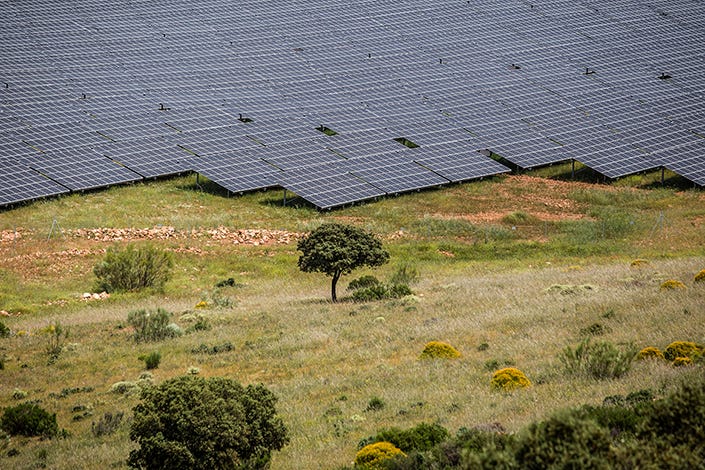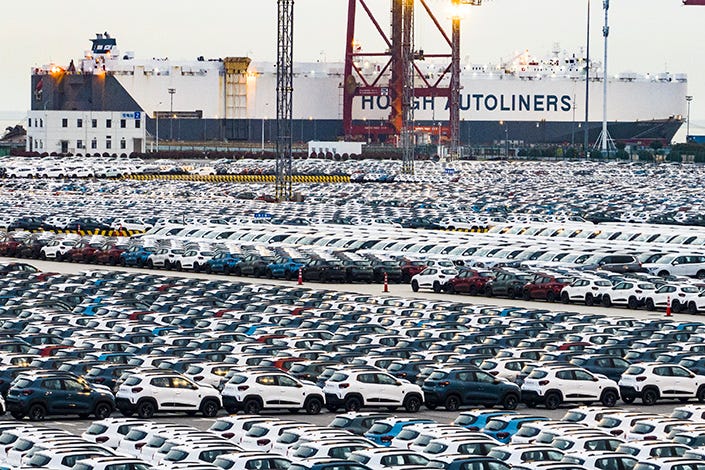What Lies Ahead for China-EU Climate Collaboration (Part 2)
Frans Timmermans, the European Commission’s top climate negotiator, speaks with Caixin about cooperating with China and the EU’s controversial carbon border tax
Locals watch a wildfire near the village of Vlyhada outside Athens on Wednesday. Several forest fires have raged on the outskirts of Greece’s capital during a prolonged recent heatwave. Photo: Milos Bicanski/VCG
What’s your view of the proposal that part of revenue from CBAM is used to fund decarbonization in China and other developing countries?
As a global community, we should consider first and foremost the countries who cannot finance their own decarbonization. China has seen tremendous economic development since the U.N. climate treaty was agreed in 1992. On several green technologies, China is already a world leader. The development has been such that China’s GDP per capita is as high as some Member States of the European Union, and already higher than several other countries on the European continent.
When it comes to global climate finance, the European Union and its Member States have been very consistent contributors, providing over 23 billion euros a year. We focus our support on the countries who are most vulnerable to climate change and who cannot shoulder that burden alone. CBAM itself will not be a direct source of revenue to finance support to these countries. But it was written into the law on CBAM as well that the EU will continue to support the most vulnerable countries through technology transfer and technical assistance to help them develop clean industrial production.
For the Net Zero Industry Act, some have argued that having the same 40% target for wind energy, which is easy to meet, and solar energy, which is difficult to reach, doesn’t make sense. Higher costs from excluding Chinese solar makers might slow EU decarbonization. How do you view this act and what’s been said about it?
First and foremost: there can be no fight against climate change without economic openness, and free, rules-based trade is crucial for the success of the global energy transition. In Europe, the Covid crisis and the impact of the Russian aggression against Ukraine have shown that dependencies can create vulnerabilities for our economy and the wellbeing of our citizens. This experience is prompting us to make sure our trade is diversified and that we have a stable access to the technologies and materials that are essential to the transition.
The proposed Net Zero Industry Act creates the possibility for Member States to consider so-called resilience criteria when they start public procurement procedures or when they hold renewable auctions. There is no exclusion or requirement to ‘Buy European;’ it is simply about enabling diversification and better management of the risks that dependence on one single source of supply could create. On solar, China’s industry has become a production powerhouse, especially in terms of scale, but I think the European industry can play a big role in innovation and preparing for the next generations of solar panels.
More generally and looking beyond solar, clean tech is already a booming market worldwide and I’m convinced there is space for many suppliers in different parts of the world. I believe that all members of the WTO have a joint responsibility to make sure global trade stays open and fair. Only then can each of us implement the changes that are necessary for our green transitions fast enough. I hope that my Chinese counterparts agree with this assessment when we meet in Beijing.
A tree stands in front of an array of solar panels in Puertollano, Spain, in May 2022. Photo: Angel Garcia/VCG
In what ways are the Net Zero Industry Act and the latest approved EU Battery Law different from the U.S.’ Inflation Reduction Act? Amid weak Chinese exports and economy, China’s EV and battery exports to Europe have been a bright spot this year. What’s your view on more Chinese EV and batteries being used in Europe?
In a net-zero future, climate action, environmental sustainability and economic activity must go hand-in-hand. The circular economy plays a big role in the EU’s pathway to climate neutrality, and the EU will therefore continue to green the rules of the game for doing business on the internal market. It is about promoting sustainable production and consumption from all companies.
On batteries specifically, there are big opportunities for manufacturers inside and outside the EU. Because the transition to electric transport will make the European Union the second biggest global market for batteries by 2030, both in terms of production and demand. The new Battery Law will help to ensure that batteries are designed to last, efficient during their entire life, and that they are produced with as much secondary raw materials as possible. At the end of their life span, it should also be possible to repurpose them for other uses or recycle them.
The obligations in the Battery Law apply to all battery manufacturers equally, irrespective of their country of origin, and it is therefore fully compliant with the rules of the WTO and the principles of free and fair trade. It stimulates manufacturers to produce the most sustainable batteries possible and it can even create a green race to the top.
The law is therefore a good example of how the European Union uses regulation to make sure that products on the internal market support not just our own transition to climate neutrality but have a positive impact on the global transition as well. The European Commission is very willing to help Chinese companies comply with our regulations; we already have a memorandum with the NDRC (National Development and Reform Commission) on the circular economy, and stand ready to implement our cooperation.
It has been argued by some, including former economic consultant to French President Emmanuel Macron, Jean Pisani-Ferry, that it is hard to fulfill all these goals at the same time: carbon neutrality, (green) industry competitiveness, upholding free-trade, and maintaining fiscal discipline. How you view this argument? In your mind, what’s the way forward for Europe?
The transition to climate neutrality is difficult. In the EU, and everywhere. We have to change an economy that was built on the use of carbon-heavy fossil fuels to an economy that runs without them. This is difficult, but it is possible. Already the first three subjects you mention actually go extremely well together: the future of industry is in green technologies and sustainability, this is where the competition will be, and this industry will not thrive, nowhere, if we do not have free, fair and open trade.
Of course, the green transition also requires a lot of investment, from both public and private sources. Public spending will likewise be needed to ensure a just transition for citizens. The European Commission has recently made proposals to reform the framework for fiscal surveillance to also take account of the need for green investment. In this light, we should also look at the amount of public money that still goes to supporting fossil fuels and the fossil fuel industry through direct or indirect subsidies such as low taxation rates. If we compare that money to the actual investment in the green transition, there is a lot that can be done to create a new balance.
Finally, market-based instruments like the European Emissions Trading System are the perfect example of how these elements can go together. By putting a price on carbon and allowing the trade of emission allowances, it brings down emissions, stimulates industrial innovation and competitiveness, and provides additional revenues for governments to invest in the transition.
Thousands of vehicles bound for Europe sit parked at the Port of Taicang on May 24 in East China’s Jiangsu province. A study by PwC predicted that by 2025 up to 800,000 Chinese-built vehicles, most of them EVs, could be sold in Europe. Photo: VCG
This year there has been some differing voices from member states on specific green measures, such as the call to delay the ban on new internal combustion engines cars in the EU by 2035. How are these being resolved?
To be sure, there was no such call to delay. To become climate neutral in 2050, we have to make sure that emissions from road transport go down. As part of that aim, the law states that from 2035, all new cars that are sold in Europe will indeed have to be emission-free. This was already agreed in October last year and this agreement was never questioned.
Under our legislation, carmakers can choose the technology with which they achieve emission-free cars. There was a request from one Member State to make it possible that also cars that run on CO2-neutral fuels could be made and allowed on the road in Europe. The European Commission is moving forward on this request and will be presenting the necessary legal proposal.
In addition to the zero-emission cars, we have also agreed and adopted the legislation to strengthen our emissions trading system, to extend it to road transport and buildings, to implement CBAM, to create a Social Climate Fund to support vulnerable citizens in the transition, to reduce emissions from sectors outside the ETS, to grow our natural carbon sinks, to increase the share of renewable energy in our economy, and to improve energy efficiency. The EU is on track to meet our climate targets for 2030 and we will stay the course.






